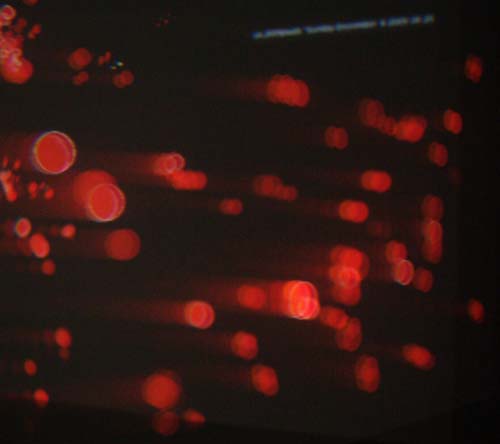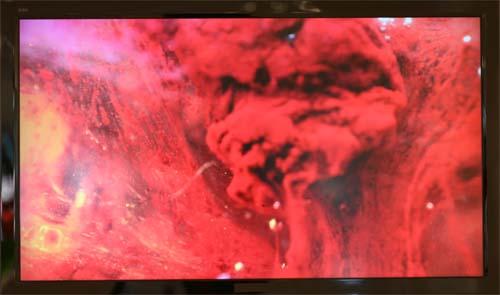
The Effect of Red On The Seeing Body
Hie yourself over to David Richard Contemporary at 130 Lincoln in Santa Fe before June 26th, where RED (Force Fields) offers up some half-dozen new video works including Noise Fields by Woody Vasulka. The show in aggregate asks about the effect of a color, red, on a viewer. How does the group of works “communicate” ? What are the fields of perception in which you receive, contribute, become aware or influence the video loop? These questions enliven much of the work here. And they also bring up context. Featured image: Marcia Lyons, RED (Force Fields 1), 2011
Three years ago, video artist Steina’s SITE Santa Fe retrospective was a lush immersive tutorial in video art – and video art display. A low-end history of video art tracked back to 1971 when the Vasulkas – Woody Vasulka and Steina – co-founded the Kitchen. By the time of Steina’s retrospective, it wasn’t lumpen stacks of old black-and-white sets that showed the video, but sleek LCD screens formed into edgeless, wireless ziggurats. Video display as luxury object. Even more so in the last three years, the impetus across the technological spectrum is to turn “viewers” into “users.” But do new forms of engagement lead users, so-called, to really experience art? It was a question I discussed earlier this spring with the Vasulkas in this podcast.
Jim Campbell, Ambiguous Icon Running and Falling, 2000

Ben Weiner's carmine red video employs fire imagery
There are no joysticks at RED, co-curated by David Eichholtz and Marcia Lyons, but there is a body of work that is spectrally resonant of strife, heat, passion- with an organizing principle of phenomena, from weather phenomena to artist Jim Campbell’s idea of a video loop’s memory, potent if dispassionate. I particularly dug C18H32O2, C20H30O2, C10H16, C22H20O13, by Ben Weiner (2010) – full of fire imagery. RED (Force Fields),the video by Marcia Lyons, uses real-time seismic data – and the viewer’s body in motion also influences the screens’ changeovers to swaths and blots of color.
At a year old, David Richard Contemporary has been interested in re-telling iterative histories of video and painting that let a viewer effectively come to new work, and consider it as interactive, full of new shapes, and strangely unfamiliar. This show is a quick study in video that suggests a strong future direction for this gallery.
